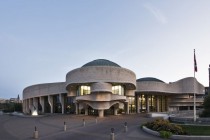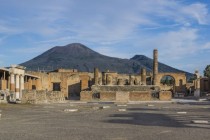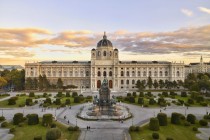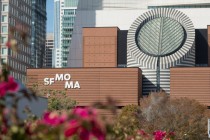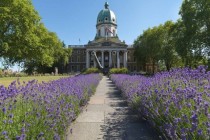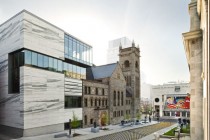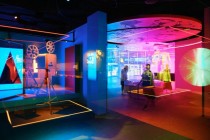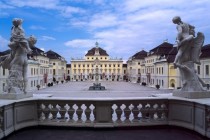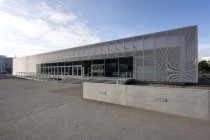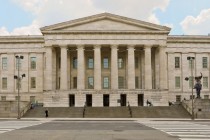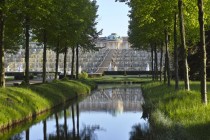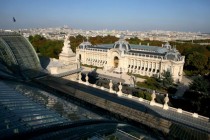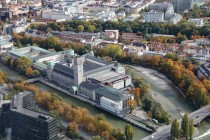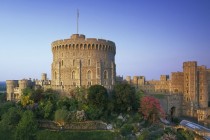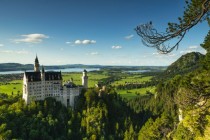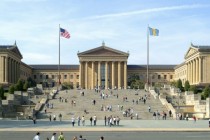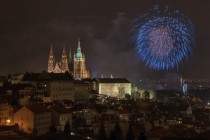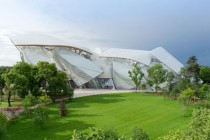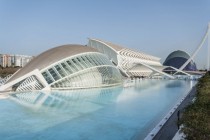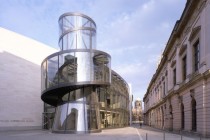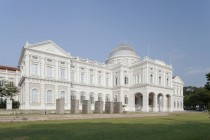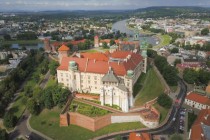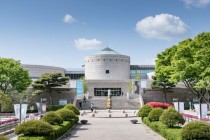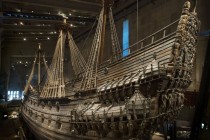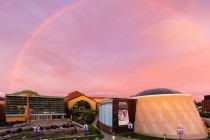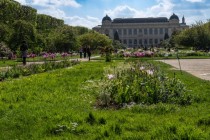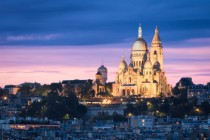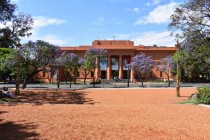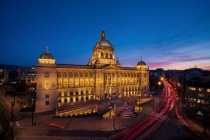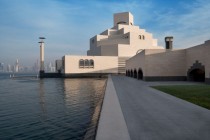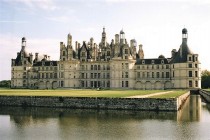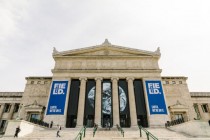| 97. |
588 |
Canadian Museum of History |
Canada |
Gatineau |
|
|
History, archaeology,... ethnography
|
More |
The Canadian Museum of History welcomes over 1.2 million visitors each year to its celebrated complex in the heart of the National Capital Region, making it one of the country's most-visited museum. With roots stretching back to 1856, it is one of Canada's oldest public institutions and a respected centre of museological excellence, sharing its expertise in history, archaeology, ethnology and cultural studies both within Canada and abroad. The National Collection consists of more than four million artifacts, specimens, works of art, written documents, and sound and visual recordings.
In addition to its ongoing exhibitions, including the spectacular Grand Hall, the First Peoples Hall, and the Canadian History Hall that provides a stunning showcase for more than 1,500 artifacts, including many of Canada's important historical treasures, each year the Museum presents a number of outstanding exhibitions focusing on Canadian and world history and civilizations. The Museum is also home to the Canadian Children's Museum.
|
| 98. |
185 |
Parco Archeologico di Pompei |
Italy |
Pompeii |
|
|
Archaeological park
|
More |
Parco Archeologico di Pompei has been operating under its current name since 2017.
Parco Archeologico di Pompei covers an area of 67 hectares of the ancient city covered with a layer of volcanic ash and pumice stone by the volcano Vesuvius during the eruption in 79 AD. At the Parco Archeologico di Pompei you can visit, among others: the Amphitheater, the Temple of Apollo, the House of Faun.
Foro © Silvia Vacca
|
| 99. |
171 |
Kunsthistorisches Museum |
Austria |
Vienna |
|
|
Art
|
More |
Kunsthistorisches Museum (KHM) opened in 1891.
Most of the collections are the collections of the imperial Habsburg family. The collections are divided into a gallery of paintings, art of ancient Egypt, Antikensammlung, Kunstkammer, Münzkabinett, and a library. KHM presents paintings for example: Raphael, Dürer, Titian, Caravaggio, Rubens, Rembrandt, Velázquez.
©KHM-Museumsverband
|
| 100. |
248 |
Taj Mahal |
India |
Agra |
|
|
Mausoleum
|
More |
Taj Mahal (Taj Museum inside Taj Mahal Complex founded in 1906).
Taj Mahal is a mausoleum built in 1632–53 by the Mughal emperor Shah Jahan to house the tomb of his prematurely deceased beloved wife, Mumtaz Mahal. It covers an area of 17 hectares.
|
| 101. |
147 |
San Francisco Museum of Modern Art |
USA |
San Francisco |
|
|
Art
|
More |
San Francisco Museum of Modern Art (SFMOMA) founded in 1935.
It collects works of modern and contemporary art. The entire collection consists of over 33,000 paintings, sculptures, photographs, design, and media art. The collection includes works of: Klee, Duchamp, Magritte, Mondrian, Kahlo, Rivera, Pollock, Warhol, Rauschenberg, de Kooning, Bacon, Rothko, Calder, Stella.
SFMOMA; photo: © Henrik Kam, courtesy SFMOMA
|
| 102. |
272 |
Imperial War Museum |
United Kingdom |
London |
|
|
Military, art
|
More |
Imperial War Museum (IWM) opened to the public in 1920.
Museums included in the IWM:
- IWM London,
- Churchill War Rooms London,
- HMS Belfast (London),
- IWM Duxford,
- IWM North.
The IWM collections mainly include:
- military vehicles (e.g. one of the first "Devil" a Mark V tanks that were used at the end of World War I),
- airplanes (e.g. the Supermarine Spitfire that flew in the Battle of Britain and the Heinkel He 162 jet fighter),
- missiles (e.g. a V-1 flying bomb, a V-2 rocket and Polaris missiles),
- documents, photos, films, videos, oral history recordings,
- a large collection of works of art.
IWM has gathered 10,700,000 individual exhibits or entire collections of exhibits from the times of the World War I until today.
|
| 103. |
180 |
Montreal Museum of Fine Arts |
Canada |
Montreal |
|
|
Art
|
More |
The Montreal Museum of Fine Arts (MMFA) founded in 1860.
The Montreal Museum of Fine Arts has five pavilions that showcase archeology and ancient art, the international art collection, Quebec and Canadian art, modern and contemporary art, decorative arts and design. The international art collection includes works by, among others, Rembrandt, Dürer, El Greco, Goya, Delacroix, Cézanne, Matisse, Miró, Monet, Picasso, Renoir, Rodin, Dalí, Moore. The collection also includes: Coptic fabrics, English porcelain, Japanese incense boxes and stained glass.
The entire collection includes over 43,000 exhibits.
The total area is 53,095 square meters, of which the exhibition area is 13,000 square meters.
Claire and Marc Bourgie Pavilion, exterior view. The Montreal Museum of Fine Arts. Photo MMFA, Michel Dubreuil
|
| 104. |
155 |
PT Taman Wisata Candi Borobudur, Prambanan, dan Ratu Boko |
Indonesia |
Magelang |
|
|
Temple, national
|
More |
PT Taman Wisata Candi Borobudur, Prambanan, dan Ratu Boko (commonly abbreviated TWC) founded in 1980 is a state-owned company that deals with the management of tourist facilities.
PT TWC manages primarily:
- Borobudur - the largest Buddhist temple complex in the world, built between 750 and 850 CE
There are three museums in the Borobudur Temple Visitor Park area: Museum Borobudur, Museum Karmawibhangga, and Museum Samudraraksa.
- Prambanan - a Hindu temple complex originally built in 850 CE
- Ratu Boko - palace complex from the 8th and 9th centuries
- Taman Mini "Indonesia Indah" (TMII) covers an area of approximately 100 ha and consists of:
Indonesia Museum
Purna Bhakti Pertiwi Museum
Soldier Museum
Indonesian Stamps Museum
Pusaka Museum
Transportation Museum
Museum Electricity & New Energy Museum
Telecommunication Museum
Penerangan Museum
Sports Museum
Asmat Museum
Komodo Indonesian Fauna Museum and Reptile Park
Insects Museum
Research & Technology Information Center
Oil & Gas Museum
East Timor Museum
Museum Bayt Al-qur'an Dan Museum Istiqlal
Museum Hakka Indonesia
|
| 105. |
298 |
Museum of Latin American Art of Buenos Aires |
Argentina |
Buenos Aires |
|
|
Art
|
More |
Museum of Latin American Art of Buenos Aires (MALBA) established in 2001.
It collects and shares Latin American art from the beginning of the 20th century to the present day. The collection has paintings, e.g. Kahlo, Rivera, Lam.
|
| 106. |
170 |
Staatliche Kunstsammlungen Dresden |
Germany |
Dresden, Leipzig, Herrnhut |
|
|
Art, ethnography
|
More |
The collection dates back to 1560. Staatliche Kunstsammlungen Dresden (Dresden State Art Collections) was named after the Dresden City Council in 1957 and has been operating as a state-owned enterprise since 2009.
1) Museums in Dresden:
- in the Albertinum building there are:
Art from the Romantic period to the present day
Skulpturensammlung ab 1800
- in the Residenzschloss building there are:
Grünes Gewölbe
Kupferstich-Kabinett
Münzkabinett
Rüstkammer
- in the Zwinger mit Semperbau building there are:
Gemäldegalerie Alte Meister
Mathematisch-Physikalischer Salon
Porzellansammlung
Skulpturensammlung up to 1800
- in the Jägerhof building there are:
Museum für Sächsische Volkskunst
Puppentheatersammlung
- in the Japanisches Palais building there are:
Museum usui publico patens
Archiv der Avantgarden
Museum für Völkerkunde Dresden
- in the Lipsiusbau building there is:
Kunsthalle im Lipsiusbau
- in the Schloss Pillnitz building there is:
Kunstgewerbemuseum
2) Museums in Leipzig:
- in the GRASSI Museum building there is:
GRASSI Museum für Völkerkunde zu Leipzig
3) Museums in Herrnhut:
- in the Völkerkundemuseum building there is:
Völkerkundemuseum Herrnhut
|
| 107. |
248 |
Australian Center for the Moving Image |
Australia |
Melbourne |
|
|
Cinema, media, art
|
More |
Australian Center for the Moving Image founded in 2002.
ACMI is a museum of digital culture, film, video games and art.
ACMI's centrepiece exhibition The Story of the Moving, photo Gareth Sobey
|
| 108. |
438 |
National September 11 Memorial & Museum |
USA |
New York |
|
|
Memorial
|
More |
National September 11 Memorial & Museum opened to the public in 2014.
The monument and museum in New York commemorate the attacks of September 11, 2001.
The museum collection includes, among others, over 40,000 paintings and 14,000 artifacts.
|
| 109. |
329 |
Staatliche Schlösser und Gärten Baden-Württemberg |
Germany |
Bruchsal |
|
|
Historic house
|
More |
Staatliche Schlösser und Gärten Baden-Württemberg (SSG; State Palaces and Gardens of Baden-Wuerttemberg) state heritage agency, an institution of public law established in 1987.
Looks after 62 palaces, gardens, castles, monasteries, ancient Roman bath ruins, sepulchral chapels, Celtic city, Domnick Collection, Prince's Little House located (or called) in Heidelberg, Ludwigsburg, Weikersheim, Schwetzingen, Bruchsal, Mannheim, Rastatt, Mergentheim , Solitude (Stuttgart), Meersburg, Tettnang, Ellwangen, Urach, Kirchheim, Salem, Bebenhausen, Karlsruhe, Hohentwiel, Rötteln, Hohenneuffen, Hochburg, Wäscherschloss, Dilsberg, Badenweiler, Yburg, Alt-Eberstein, Hohenstaufen, Maulenbronnor, Wiulenbronnor, Schussenried, Grosscomburg, Hirsau, Schöntal, Alpirsbach, Ochsenhausen, Heiligkreuztal, Stuttgart, Heuneburg, Nürtingen, Hüfingen, Meersburg.
Photo: Ludwigsburg Residential Palace, Exteriors; Staatliche Schlösser und Gärten Baden-Württemberg, Ralf Cohen
|
| 110. |
535 |
Van Gogh Museum |
Netherlands |
Amsterdam |
|
|
Art
|
More |
Van Gogh Museum opened to the public in 1973.
The museum stores 200 paintings by Vincent van Gogh (1853-1890) from all periods of his work, 400 drawings and 700 letters. The collection enriches the paintings of other outstanding European painters from 1840-1920.
|
| 111. |
270 |
Topography of Terror |
Germany |
Berlin |
|
|
Memorial
|
More |
The Topography of Terror opened to the public in 2010.
During the Third Reich (1933-1945), the site currently occupied by The Topography of Terror was the seat of the Gestapo, SS and the Reich Main Security Office. Nazi buildings were destroyed by the Allied bombing in 1945. Later the Berlin Wall passed through this place. A large part of the Wall in The Topography of Terror survived to this day. The first exhibitions in this place took place from 1987.
Entrance to the documentation center
|
| 112. |
146 |
National Portrait Gallery |
USA |
Washington |
|
|
Art
|
More |
Established in 1962, the National Portrait Gallery is part of the Smithsonian Institution.
The National Portrait Gallery tells the history of America by presenting portraits of famous Americans - politicians, artists, scientists, explorers. It has, among other things, a representative collection of portraits of American presidents.
The National Portrait Gallery has gathered over 23,000 objects.
National Portrait Gallery Building by Tony Powell, 2019
|
| 113. |
169 |
Peterhof Palace |
Russia |
St Petersburg |
|
|
Historic house
|
More |
Peterhof Palace built by Tsar Peter the Great in 1714–1723. The palace and park complex with numerous fountains, among others the Grand Cascade. Area: 3 934 hectares.
|
| 114. |
475 |
Stiftung Preußische Schlösser und Gärten Berlin-Brandenburg |
Germany |
Potsdam |
|
|
Historic house
|
More |
Stiftung Preußische Schlösser und Gärten Berlin-Brandenburg (SPSG; Prussian Palaces and Gardens Foundation Berlin-Brandenburg) began operating in 1995.
The SPSG deals with the most important testimonies of Brandenburg-Prussia's culture, architecture and art history from the 17th century to the 20th century.
SPSG manages 30 museum castles and other museums, 800 hectares of historic parks, 100,000 works of art, 150 monuments and 300 architectural objects.
1) Palaces and gardens in Berlin:
Jagdschloss Grunewald
Jagdzeugmagazin am Jagdschloss Grunewald
Schlossgarten Charlottenburg
Schloss Charlottenburg
Neuer Pavillon im Schlossgarten Charlottenburg
Mausoleum im Schlossgarten Charlottenburg
Schloss Charlottenburg – Theaterbau
Schlossgarten Schönhausen
Schloss Schönhausen
Pfaueninsel
Schloss auf der Pfaueninsel
Meierei auf der Pfaueninsel
Park Glienicke
Schloss Glienicke
Casino Glienicke
2) Palaces and gardens in Potsdam:
Park Sanssouci
Schloss Sanssouci
Schlossküche Sanssouci
Damenflügel Schloss Sanssouci
Bildergalerie
Neue Kammern
Historische Mühle
Normannischer Turm auf dem Ruinenberg
Neues Palais
Belvedere auf dem Klausberg
Chinesisches Haus
Orangerieschloss
Schloss Charlottenhof
Römische Bäder im Park Sanssouci
Friedenskirche
Dampfmaschinenhaus (Moschee)
Neuer Garten
Schloss Cecilienhof
Marmorpalais
Belvedere auf dem Pfingstberg
Pomonatempel auf dem Pfingstberg
Park Babelsberg
Schloss Babelsberg
Flatowturm im Park Babelsberg
Park Sacrow
Schloss Sacrow
Jagdschloss Stern
3) Palaces and gardens in the state of Brandenburg:
Schloss & Lustgarten Rheinsberg
Schlossmuseum Oranienburg
Schloss & Schlossgarten Caputh
Schloss & Schlossgarten Königs Wusterhausen
Schloss & Schlossgarten Paretz
Schlossremise Paretz
|
| 115. |
385 |
National Galleries of Scotland |
United Kingdom |
Edinburgh |
|
|
National - art
|
More |
National Galleries of Scotland organized in 1985. Brings together:
Scottish National Gallery,
Scottish National Portrait Gallery,
Scottish National Gallery of Modern Art,
Paxton House,
Duff House,
Granton Center for Art.
Has nearly 100,000 esponates in its collection, which includes works by artists such as Titian, Rembrandt, Picasso, Hockney, and Warhol.
|
| 116. |
157 |
Hagia Sophia |
Turkiye |
Istanbul |
|
|
Temple
|
More |
Hagia Sophia in the past a Christian temple, then a mosque, from 1935 a museum, from 2020 a mosque.
Built in 537. A leading example of Byzantine architecture. Length 82 meters, width 73 meters, height 55 meters.
|
| 117. |
166 |
Kelvingrove Art Gallery and Museum |
United Kingdom |
Glasgow |
|
|
Art
|
More |
Kelvingrove Art Gallery and Museum established in 1901.
Has a collection of military items and natural history. The painting collection includes paintings by Rembrandt, Monet, Renoir, van Gogh, and Dalí.
|
| 118. |
147 |
Tsarskoe Selo |
Russia |
Pushkin |
|
|
Historic house
|
More |
Tsarskoe Selo (the Tsarskoe Selo State Museum and Heritage Site) was the summer residence of the Russian Tsars. Expanded from the beginning of the 18th century to the beginning of the 20th century. The main buildings of the residential complex are Catherine Palace erected in the style of Russian Baroque and the classical Alexander Palace. There was now a lost Amber Room in Catherine Palace. Currently, the reconstruction can be visited at Catherine Palace. In the palace-and-park ensemble of Tsarskoe Selo covering an area of 300 hectares, there are scattered over one hundred historical monuments.
In 1918, Catherine Palace was opened as a museum.
|
| 119. |
158 |
Petit Palais |
France |
Paris |
|
|
Art
|
More |
Petit Palais founded in 1900.
Petit Palais - City of Paris Fine Art Museum presents collections of: medieval and Renaissance paintings and drawings, furniture from the 18th century, works of French artists of the 19th century (among others: Ingres, Delacroix, Courbet, Monet, Cézanne, Modigliani, Rodin).
Petit Palais vu du Grand Palais © Didier Messina, 2013
|
| 120. |
324 |
Suzhou Museum |
China |
Suzhou |
|
|
Art
|
More |
Suzhou Museum founded in 1960.
The exhibition area covers 2,200 square meters. The collection consists of over 15,000 exhibits. Most are ancient Chinese paintings and calligraphy, ceramics, arts and crafts. The collection of paintings and calligraphy includes works of masters from the Song dynasty through the Ming dynasty to the Qing dynasty.
|
| 121. |
132 |
Bodleian Library |
United Kingdom |
Oxford |
|
|
Library
|
More |
The Bodleian Library at the University of Oxford was officially established in 1602 by Sir Thomas Bodley. The library opened to the public on November 8, 1602.
The Bodleian Library is one of the most significant libraries in the world, with extensive collections spanning various subjects. Some of its most notable collections include:
1. Manuscripts and Rare Books
- Medieval Manuscripts – Includes illuminated manuscripts, such as the Ashmole Bestiary and The Book of Hours.
- Gutenberg Bible – One of the earliest books printed with movable type.
- Shakespeare’s First Folio (1623) – A rare edition of Shakespeare’s collected plays.
- Celtic and Anglo-Saxon Manuscripts – Including the Lindisfarne Gospels and Red Book of Hergest.
2. Maps and Cartography
- Gough Map (c. 1360) – One of the earliest detailed maps of Britain.
- Selden Map of China (17th century) – A rare Chinese maritime trade map.
3. Personal Papers and Archives
- J.R.R. Tolkien’s Papers – Including drafts and illustrations for „The Lord of the Rings and The Hobbit”.
- C.S. Lewis Collection – Personal writings of the author of „The Chronicles of Narnia”.
- Mary Shelley’s „Frankenstein” – Original handwritten manuscript.
- Letters and Diaries of British Prime Ministers – Including papers from Winston Churchill.
4. Eastern and Non-Western Collections
- Islamic Manuscripts – Including Persian, Arabic, and Ottoman texts.
- Chinese, Japanese, and Sanskrit Texts – Rare books from across Asia.
- Hebrew Manuscripts – Important Jewish texts, including biblical and Talmudic works.
5. Scientific and Medical Collections
- Codex Mendoza – A 16th-century Aztec codex detailing the history and culture of the Aztec Empire.
- John Dee’s Collection – Works of the famous Elizabethan alchemist and astrologer.
- Robert Hooke’s Micrographia – A groundbreaking 1665 book on early microscopy.
6. Modern and Digital Archives
- Literary Archives – Includes modern authors such as Philip Pullman.
- Oxford University Archives – Documents related to the history of the university.
- Digitized Collections – Many manuscripts and books are available online through projects like Digital Bodleian.
The Bodleian Libraries at the University of Oxford collectively hold over 13 million printed items. Additionally, they house more than one million special collection items, including manuscripts, archives, and rare books.
The Bodleian Libraries at the University of Oxford encompass multiple buildings with a combined gross internal floor area of approximately 42,774 square meters as of the 2020–2021 period. Additionally, the Book Storage Facility (BSF) in Swindon, designed to house lower-usage items from the libraries' collections, offers around 10,000 square meters of warehouse space, complemented by 1,000 square meters of ancillary office and processing areas. Therefore, the combined area of the Bodleian Libraries' main buildings and the BSF is approximately 53,774 square meters.
The Bodleian Library at the University of Oxford features several exhibition spaces, primarily within the Weston Library. The main public area, Blackwell Hall, serves as the central hub for visitors, offering access to exhibitions, a café, and a gift shop. While the exact total exhibition area isn't specified in the available sources, the Weston Library includes a hall measuring 854 square meters, which is utilized for various events, including exhibitions. Additionally, the Old Schools Quadrangle, part of the historic Bodleian complex, houses spaces that have been repurposed for exhibitions and other public functions.
|
| 122. |
202 |
Parco archeologico del Colosseo |
Italy |
Rome |
|
|
Archaeological park
|
More |
Parco archeologico del Colosseo founded in 2017.
It covers the most important monuments and historical places of ancient Rome, among others: The Colosseum, The Palatine, Roman Forum, Arch of Constantine and Meta Sudans, The Domus Aurea.
|
| 123. |
526 |
German Museum of Masterpieces of Science and Technology |
Germany |
Munich |
|
|
Science and technology
|
More |
German Museum of Masterpieces of Science and Technology known as Deutsches Museum founded in 1903.
It collects collections from almost all fields of technology, industry and science. Its collections include: the first electric locomotive, a three-wheeled car from 1886 designed by Karl Benz and a Leibniz accounting machine.
The museum has gathered around 120,000 exhibits, of which around 28,000 are open to the public at exhibitions.
It covers an area of over 60,000 square meters.
Photo: © Bernd Wackerbauer
|
| 124. |
213 |
Sagrada Família |
Spain |
Barcelona |
|
|
Temple
|
More |
Sagrada Família started in 1882, not yet completed Roman Catholic minor basilica. Designed by Antoni Gaudí (1852–1926) in Style Modernisme. Length 90 meters, width 60 meters, planned height 172.5 meters. The Sagrada Familia has a museum inaugurated in 1961.
|
| 125. |
170 |
Windsor Castle |
United Kingdom |
Windsor |
|
|
Historic house
|
More |
Windsor Castle is a royal residence built in the three bailey wards with a round keep type since the 11th century. In the Lower Ward there is the St George's Chapel and the Albert Memorial Chapel - royal mausoleums. The Upper Ward houses the royal library, with a collection of drawings by, among others, Leonardo da Vinci, Raphael, Hans Holbein the Younger.
Windsor Castle is 800 meters long. It covers an area of 53,000 square meters. It is the largest inhabited castle in the world.
The castle is surrounded by a 200-hectare Home Park. Within the park there is Frogmore House with its garden, which houses the mausoleum of Queen Victoria and Prince Albert. Further south from Windsor Castle is the Great Park, covering approximately 700 hectares.
Royal Collection Trust / © His Majesty King Charles III 2024, photo Peter Packer
|
| 126. |
210 |
Bayerische Verwaltung der staatlichen Schlösser, Gärten und Seen |
Germany |
Munich |
|
|
Historic house
|
More |
Bayerische Verwaltung der staatlichen Schlösser, Gärten und Seen (Bavarian Administration of State-Owned Palaces, Gardens and Lakes), also called Bayerische Schlösserverwaltung (Bavarian Palace Department), traces its historical origins to the 18th century.
Bavarian Palace Department manages:
1) palaces:
Ansbach
Aschaffenburg
Bamberg
Bayreuth
Burghausen
Cadolzburg
Chiemsee
Coburg
Dachau
Eichstätt
Ellingen
Feldafing
Herrenchiemsee
Höchstädt
Holzhausen
Kelheim
Kempten
Königssee
Kulmbach
Landshut
Linderhof
Ludwigsstadt
Munich
Neuburg
Neuschwanstein (The construction of Neuschwanstein Castle for the Bavarian King Ludwig II Wittelsbach began in 1869. The building was built in honor of the German composer Ryszard Wagner as an idealized medieval knight's castle. The architecture and interior design are marked by the romantic eclecticism of the 19th century, and the building itself is one of the most important works of historicism. After the king's death in 1886, the castle was opened to the public. Usable area of about 6,000 square meters.)
Nuremberg
Riedenburg
Schachen
Schleißheim
Veitshöchheim
Würzburg
2) gardens:
Ansbach
Aschaffenburg
Bamberg
Bayreuth
Cadolzburg
Coburg
Dachau
Eichstätt
Ellingen
Feldafing
Herrenchiemsee
Holzhausen
Linderhof
Munich
Nuremberg
Schleißheim
Veitshöchheim
Würzburg
3) fortifications, villas, theaters, opera houses, memorial sites and 21 lakes.
© Bayerische Schlösserverwaltung
www.schloesser.bayern.de
Neuschwanstein view from the Marienbrücke
Photo Martha Feustel
|
| 127. |
231 |
Chichen Itza |
Mexico |
Pisté |
|
|
Archaeological park
|
More |
Chichen Itza is an ancient Maya and Toltec Mesoamerican city. The main monuments are: Temple of Kukulcan, Temple of the Warriors, Great Ball Court, Sacred Cenote. Managed by the Instituto Nacional de Antropología e Historia (INAH) - National Institute of Anthropology and History.
|
| 128. |
150 |
Museo Nazionale di Castel Sant'Angelo |
Italy |
Rome |
|
|
Mausoleum, history
|
More |
The Castel Sant'Angelo Museum opened in 1906.
The building of the current museum was built in 139 as the mausoleum of Emperor Hadrian. In the Middle Ages rebuilt into a fortress. In 1367, the keys to the fortress were handed over to the then Pope Urban V. Further popes carried out further reconstruction using the monument as a shelter in times of danger, archives, court and prison.
Museo Nazionale di Castel Sant'Angelo can be divided into 3 parts: mausoleum, fortified castle, papal apartments.
|
| 129. |
224 |
National Museum of India |
India |
New Delhi |
|
|
Art, archeology,... anthropology, history
|
More |
National Museum of India founded in 1949.
Its collections include artifacts covering over 5000 years of history, from the prehistoric era to modern works of art. The museum has 206,000 objects in its collections.
It is divided into collections:
Pre - Histroic Archaeology
Archaeology
Anthropology
Paintings (mainly miniature painting)
Arms & Armour
Central Asian Antiquities
Decorative Arts
Manuscripts
Numismatic & Epigraphy
Pre-Columbian & Western Art
|
| 130. |
177 |
Giza pyramid complex |
Egypt |
Giza |
|
|
Mausoleum, history
|
More |
Giza pyramid complex
A set of historic buildings including the two largest pyramids built in ancient Egypt: the Great Pyramid of Giza and the Pyramid of Khafre and the smaller Pyramid of Menkaure, Great Sphinx and other accompanying objects. The complex covers an area of 16,203.36 hectares.
|
| 131. |
243 |
National Palace Museum of Korea |
South Korea |
Seoul |
|
|
Art, history
|
More |
National Palace Museum of Korea founded in 1908 as the Korean Imperial Museum. The museum occupies in Gyeongbokgung Palace, Seoul. In its collection, the museum has over 40,000 artifacts from the time of Joseon Dynasty and the Korean Empire.
|
| 132. |
513 |
Philadelphia Museum of Art |
USA |
Philadelphia |
|
|
Art
|
More |
The Philadelphia Museum of Art was founded in 1876.
It has significant collections of European, American and Asian art. The Philadelphia Museum of Art includes, among others: the world's largest collection of works by Marcel Duchamp, an important collection of sculptures by Auguste Rodin, important paintings by Édouard Manet, Claude Monet, Pierre-Auguste Renoir, Paul Cézanne and Vincent van Gogh, the richest collection of paintings in the USA by Thomas Eakins, a collection of Paul Strand's photographs, Shakers' crafts, numerous "period rooms" and architectural ensembles from around the world, e.g. from China, India, Japan, United Kingdom and France, a collection of weapons and combat gear second largest in the USA.
The entire collection of the Philadelphia Museum of Art includes over 240,000 exhibits.
|
| 133. |
157 |
Tokyo Imperial Palace |
Japan |
Tokyo |
|
|
Historic house
|
More |
The main residence of the Emperor of Japan. A complex of buildings and pavilions for various purposes and gardens covering an area of 115 hectares. The current Imperial Palace is located within the former Edo Castle (Tokyo was formerly Edo). In 1888, the construction of the imperial castle was completed, which was destroyed during World War II and rebuilt after it. The renovation and modernization of the entire complex was completed in 1968. Main facilities include: Imperial Palace (Kyūden), Imperial Household Agency, Museum of the Imperial Collections, Archives and Mausolea Department.
Museum of the Imperial Collections was opened in 1993. It has collected around 9,500 works of art in its collection. It is mainly Japanese painting (Nihonga), calligraphy, sculpture, arts and crafts.
|
| 134. |
314 |
Centro Cultural Banco do Brasil |
Brazil |
Brasília |
|
|
Art
|
More |
Centro Cultural Banco do Brasil, Brasília opened in 2000. It covers an area of 7,000 square meters.
Museu Banco do Brasil has in its collection works of artists from the first half of the 20th century, such as Bruno Giorgi, Candido Portinari, Emiliano Di Cavalcanti.
|
| 135. |
162 |
National Taiwan Science Education Center |
Chinese Taipei |
Taipei |
|
|
Science and technology
|
More |
The National Taiwan Science Education Center (NTSEC) was founded in 1956.
NTSEC deals with broadly understood scientific education. It presents permanent and temporary exhibitions mainly in the field of natural and earth sciences, mathematics, physics, chemistry and materials science.
|
| 136. |
192 |
Musée de l'Orangerie |
France |
Paris |
|
|
Art
|
More |
Musée de l'Orangerie opened in 1927. In 2010, it joined the Musée d'Orsay.
Musée de l'Orangerie exhibits Claude Monet's Water Lilies cycle consisting of 8 panels, each 2 meters high and 91 meters long, arranged in 2 oval galleries. In the Musée de l'Orangerie you can also see paintings by other Impressionists and Post-impressionists, such as Paul Cézanne, Henri Matisse, Amedeo Modigliani, Pablo Picasso, Pierre-Auguste Renoir.
Area of 6,300 square meters.
|
| 137. |
257 |
Guangdong Museum of Revolutionary History |
China |
Guangzhou |
|
|
History
|
More |
The Guangdong Museum of Revolutionary History was founded in 1959.
The museum is located in the building of the former Guangdong Advisory Bureau in the Guangzhou Uprising Martyrs Cemetery of Guangdong Province.
The exhibitions show the struggle of the local people for national independence from the Opium War in 1840 to the national liberation in 1949, including the Civil Revolutionary War (1927-1937, 1946-1949).
The museum covers an area of 2000 square meters. At permanent exhibitions, it presents 13,000 exhibits and 13,000 archival photos.
|
| 138. |
152 |
Prague Castle |
Czech |
Prague |
|
|
Historic house
|
More |
Prague Castle - a castle complex built from the 9th century in all historical architectural styles. One of the largest castles in the world, it covers an area of almost 7 ha. It was the seat of Czech kings, Roman emperors and Czechoslovak presidents. It stores the Czech Crown Jewels.
Main objects:
- Old Royal Palace
- St. Vitus Cathedral
- St. George's Basilica
- Queen Anne's Summer Palace (Belvedere)
- Spanish Hall
- Vladislav Hall
There are several museums in the castle, including:
- collection of Czech baroque and mannerism of the National Gallery
- Prague Castle picture gallery, referring to the collection of Rudolf II
- exhibition on the history of the Czech Republic
- toy museum
Photo: © Prague City Tourism
|
| 139. |
177 |
Opera della Primaziale Pisana |
Italy |
Pisa |
|
|
Temple, art
|
More |
Opera della Primaziale Pisana (O₽A) is a secular-ecclesiastical body managing the complex of the Cathedral of Pisa. Its origins date back to 1063.
O₽A includes the Cathedral, the Leaning Tower of Pisa, the Baptistery and the Camposanto (monumental cemetery). As well as the Sinopie Museum (Sinòpia - a preparatory drawing applied to the first layer of plaster under the fresco), opened in 1979, and the Opera del Duomo Museum, opened in 1986, exhibiting the treasures of the cathedral and other finds excavated within the cathedral complex.
|
| 140. |
163 |
Pena Palace |
Portugal |
Sintra |
|
|
Historic house
|
More |
Pena Palace built in 1842–1854 for King Ferynand II by the engineer Wilhelm von Eschwege. The eclectic palace is one of the main objects of the 19th century Romanticism in the world. The palace is surrounded by a 200-hectare forest park.
|
| 141. |
174 |
Museo Soumaya |
México |
Mexico City |
|
|
Art
|
More |
Museo Soumaya founded in 2011.
It has 66,000 works of art in its collection; including sculptures from all periods of pre-Hispanic Mesoamerica, paintings by Mexican artists such as Diego Rivera or Rufino Tamayo, a collection of coins from pre-Hispanic and colonial times. Museo Soumaya has a collection of works by European sculptors and painters, including: Auguste Rodin, Salvador Dalí, Pablo Picasso, Joan Miró.
The museum is located in 3 places: Plaza Carso (16,000 square meters), Plaza Loreto, Casa Guillermo Tovar de Teresa.
|
| 142. |
294 |
Solomon R. Guggenheim Museum |
USA |
New York |
|
|
Art
|
More |
The Solomon R. Guggenheim Museum was established in 1939 as the Museum of Non-Objective Painting. The museum collects impressionist, post-impressionist, modern and contemporary art. Its collections include works by artists such as Paul Cézanne, Georges Braque, Fernand Léger, Paul Klee.
|
| 143. |
162 |
Fondation Louis Vuitton |
France |
Paris |
|
|
Art
|
More |
The Fondation Louis Vuitton (FLV) opened in 2014.
The museum is dedicated to contemporary art. The museum's collection will include works by artists such as Gerhard Richter, Christian Boltanski, Jeff Koons, Jean-Michel Basquiat.
The FLV manages the Espace Louis Vuitton. The Espace Louis Vuitton is an exhibition place encouraging creation of new contemporary artworks in Tokyo, München, Venezia, Beijing, Seoul and Osaka..
© Iwan Baan / Fondation Louis Vuitton, 2014
|
| 144. |
187 |
Tate Britain |
United Kingdom |
London |
|
|
Art
|
More |
Tate Britain has been under this name since 2000. The origins of Tate Britain date back to 1897. Tate Britain presents British painting and sculpture from 1500 to the present day. The collection includes paintings by William Blake, JMW Turner, and Francis Bacon.
|
| 145. |
183 |
Kazan Kremlin |
Russia |
Kazan |
|
|
Art
|
More |
Kazan Kremlin erected by the Tsar of Russia Ivan Grozny in the 16th century on the ruins of the former castle of the Kazan khans built from the 10th century.
Main objects:
- Annunciation Cathedral,
- Söyembikä Tower,
- Spasskaya Tower.
The museum in its present shape as the Museum-reserve "Kazan Kremlin" was established in 1994. The entire museum complex includes:
- Museum of the History of Statehood of Tatarstan,
- Center "Hermitage-Kazan",
- Museum of Islamic Culture,
- Museum of Natural History of Tatarstan,
- Museum of the Cannon Yard,
- Exhibition Hall "Manege",
- Museum of the History of the Annunciation Cathedral,
- Museum of the Great Patriotic War,
- Museum of Fine Arts of the Republic of Tatarstan - Art Gallery.
|
| 146. |
503 |
Museu de les Ciències Príncipe Felipe |
Spain |
Valencia |
|
|
Science and technology
|
More |
Museu de les Ciències Príncipe Felipe opened in 2000 and is part of the City of Arts and Sciences.
The museum is dedicated to science, new technologies and the natural environment, and it houses exhibitions on the heritage of science, climate change, the human body and biometric data. The motto of the museum is: "It is forbidden: not to touch, feel or think".
It covers an area of over 42,000 square meters, of which 26,000 square meters are dedicated to exhibitions.
|
| 147. |
347 |
Tel Aviv Museum of Art |
Israel |
Tel Aviv |
|
|
Art
|
More |
Tel Aviv Museum of Art was established in 1932.
It collects contemporary and modern art. Its collections include works by, among others: Gustav Klimt, Wassily Kandinsky, Pablo Picasso, Roy Lichtenstein, Henry Moore, Jackson Pollock.
|
| 148. |
244 |
Museum of Fine Arts |
USA |
Houston |
|
|
Art
|
More |
Museum of Fine Arts founded in 1900.
It has over 70,000 exhibits in its collection from antiquity to the present day. The collection consists of art: European (e.g. Sandro Botticelli, Francisco Goya, Peter Paul Rubens, Claude Monet, Pierre-Auguste Renoir, Édouard Manet, Paul Cézanne, Vincent van Gogh), American (e.g. Charles Willson Peale, Albert Bierstadt, Mary Cassatt , Georgia O'Keeffe, Alexander Calder, Jackson Pollock, Robert Rauschenberg, Andy Warhol), Latin America (e.g. David Alfaro Siqueiros), Africa, Asia (e.g. Utamaro Kitagawa), Australia and Oceania, Islam, photography (e.g. Man Ray, Alfred Stieglitz).
|
| 149. |
286 |
Royal Museums of Fine Arts of Belgium |
Belgium |
Brussels |
|
|
Art
|
More |
Royal Museums of Fine Arts of Belgium founded in 1803.
It consists of the Oldmasters Museum, Modern Museum, Magritte Museum, Fin-de-Siècle Museum, Meunier Museum, Wiertz Museum. It has 20,000 paintings, sculptures and drawings that date from the beginning of the 15th century to the present day. The collected works of art are by, among others: Pieter Bruegel, Peter Paul Rubens, Jacques Jordaens, Paul Gauguin, Vincent van Gogh, Salvador Dalí, Paul Delvaux, René Magritte, Henry Moore.
|
| 150. |
203 |
Museum of Contemporary Art Australia |
Australia |
Sydney |
|
|
Art
|
More |
Museum of Contemporary Art Australia (MCA) established 1991.
It collects contemporary art from Australia (has over 4,500 works by Australian artists) and around the world.
|
| 151. |
206 |
Shenzhen Museum |
China |
Shenzhen |
|
|
History, archaeology,... ethnography, art, natural history
|
More |
Shenzhen Museum founded in 1981, opened to the public in 1988.
It consists of the Shenzhen Museum of History and Folk Culture, Shenzhen Museum of Ancient Art, Dongjiang River Guerrilla Command Headquarters Memorial Museum and Shenzhen Reform and Opening-up Exhibition Hall.
It has a total area of over 60,000 square meters. It stores over 40,000 exhibits.
|
| 152. |
176 |
National Science and Technology Museum |
Chinese Taipei |
Kaohsiung |
|
|
Science and technology
|
More |
The National Science and Technology Museum (NSTM) opened to the public in 1997.
NSTM covers an area of 19 hectares, the area of one floor is 112,400 square meters. It presents 18 permanent exhibitions in separate halls. Permanent exhibitions are devoted to: industrial history, air navigation and aerospace, biological technology, clothing and textiles, healthy living, food industry, energy conservation, machines, utilization of water resources, transportation, the diseases prevention.
|
| 153. |
345 |
Museu Picasso |
Spain |
Barcelona |
|
|
Art
|
More |
The Museu Picasso opened in 1963.
The museum has over 4,000 works by the painter Pablo Picasso (1881-1973). The permanent exhibition features the artist's painting, drawing, engraving, and ceramics.
The Museu Picasso was the first museum in the world dedicated to the work of Pablo Picasso and the only one created during his lifetime.
The total area of the museum is over 12,000 square meters.
|
| 154. |
151 |
German Historical Museum |
Germany |
Berlin |
|
|
History
|
More |
The German Historical Museum (DHM) was founded in 1987 and opened its first exhibitions to the public in 1991.
DHM presents the history of Germany from the Middle Ages (when formally there was no country using the name Germany) to the present day in an international context.
The collection comprises about 1,000,000 exhibits. You can see, among others, the boat that escaped two GDR citizens or the prosthetic hand of a medieval knight.
|
| 155. |
198 |
Zona Arqueológica de Tulum |
Mexico |
Tulum |
|
|
Archaeological park
|
More |
Tulum is a former Mayan city that was surrounded by a wall.
Its history dates back to at least the 6th century AD. Its peak development falls between the 13th and 15th centuries. After the occupation by the Spaniards in the 16th century, the city was deserted.
Main historic buildings: Temple of the Frescoes, Temple of the Descending God, El Castillo.
|
| 156. |
373 |
Changdeokgung Palace |
South Korea |
Seoul |
|
|
Historic house
|
More |
Changdeokgung Palace was built between 1405 and 1412 during the reign of King Taejong, the third king of the Joseon dynasty, as the second royal palace after Gyeongbokgung (the main palace of the dynasty), currently the National Palace Museum of Korea. In 1592, during the Japanese invasion of Korea (Imjin War), it was burned down. The reconstruction of the palace began only in 1609 during the reign of King Seonjo, and was completed during the reign of his successor, King Gwanghaegun. Later, Changdeokgung was destroyed and rebuilt several times, especially in the 18th century. In 1910, after the annexation of Korea by Japan, the palace was taken over by the Japanese authorities and part of it was destroyed. During the Japanese occupation (1910–1945), many palace buildings were demolished or transformed. After Korea regained independence, Changdeokgung underwent numerous restoration works.
Changdeokgung Palace was built in the traditional Korean architectural style that is characteristic of the Joseon Dynasty period (1392–1897). This style of architecture emphasizes harmony with the surrounding nature and introduces elements of Confucianism, which played a key role in Korean society and culture during this period. These are the main features of the style in which Changdeokgung was built:
1. Harmony with the surroundings - Changdeokgung was built in a way that aimed to integrate the building with the natural landscape, in accordance with the principles of geomancy (feng shui). The palace did not disturb the natural terrain, which is visible in its asymmetric layout. The palace area was incorporated into hills and valleys, preserving the natural shape of the land.
2. Asymmetrical layout - unlike the symmetrical palaces in China or Japan, Changdeokgung has a more organic, asymmetrical layout due to its harmony with the surrounding nature. The buildings are arranged in accordance with the natural terrain, which gives a sense of spaciousness and naturalness.
3. Simple yet elegant architecture - Changdeokgung's architecture is characterized by simplicity and minimalism, which is in line with Confucian values. Wooden structures, tiled roofs and decorative details are carefully designed to be aesthetically pleasing but not overdone. The roofs of the buildings have characteristic, slightly bent ends, which is typical of traditional buildings in Korea.
4. The beauty of details - the palace is richly decorated with details, such as painted wooden beams (so-called dancheong), which are covered with colorful geometric and floral patterns. Dancheong has both a decorative and protective function, protecting the wood from harmful weather conditions.
5. Huwon Garden (Secret Garden) - also known as the Complex Garden, is an integral part of the palace complex and a perfect example of striving for harmony with nature. The garden includes picturesque ponds, pavilions, pagodas and bridges that have been designed to be fully integrated with the natural landscape.
6. Building material - the primary material used for construction is wood, and the buildings have traditional roofs covered with clay tiles. Many of the palace's buildings, including the most important halls, are built of wooden frames and have open spaces, which allows for natural ventilation of the rooms.
Changdeokgung Palace consists of many buildings with different functions that played key roles in the life of the royal court of the Joseon Dynasty. These are the main buildings of Changdeokgung Palace:
1. Injeongjeon (Throne Room)
2. Seonjeongjeon (Board Hall)
3. Huijeongdang (King's Personal Hall)
4. Daejojeon (Queen's Chamber)
5. Nakseonjae (King Heonjong's private residence built in the 19th century)
7. Donhwamun (Main Gate)
8. Juhamnu (Royal Library Pavilion)
Changdeokgung Palace does not have a permanent museum collection, it is mainly a royal residence and a historical monument. Nevertheless, there are valuable monuments, artifacts and collections related to Korean history and the Joseon dynasty, which can be seen as part of temporary exhibitions or special events.
Here are some of the resources and collections related to Changdeokgung:
1. Architectural monuments and decorations
- Dancheong: The colorful paintings on the wooden palace structures are some of the most beautiful examples of traditional decoration in Korean architecture. These decorations, which are an important element of cultural heritage, decorate the beams, ceilings and roofs of the palace buildings.
- Pavilions and Bridges: Located in the palace gardens (Huwon), pavilions such as Buyongjeong, Juhamnu, and stone bridges are valuable examples of Korean architecture and are considered national heritage.
2. Collections related to the Joseon dynasty
- Royal clothing (hanbok): Traditional royal clothing, including the ceremonial robes of the king, queen and members of the royal family.
- Royal furniture: Original wooden furniture used by rulers, such as desks, chairs, beds and other elements of palace interior design.
- Musical Instruments: Traditional instruments that were used in court ceremonies and celebrations, such as drums, gongs, and other stringed and percussion instruments.
3. Manuscripts and historical documents
- Administrative books: Documents describing the daily functioning of the royal court, as well as important political decisions.
- Royal Letters and Records: Documents containing correspondence between members of the royal family or records of kings.
4. Royal arts and crafts
- Ceramics and Porcelain: Ceramics that were used at court, including Korean celadon and white porcelain.
- Painting and calligraphy: Traditional court paintings, often depicting landscapes, plants and scenes from court life, are presented in temporary exhibitions.
Changdeokgung Palace covers an area of approximately 58 hectares, of which Huwon Garden covers approximately 32 hectares.
|
| 157. |
221 |
Berlin Wall Memorial |
Germany |
Berlin |
|
|
Memorial
|
More |
The Berlin Wall Memorial created in 1998 commemorates the division of Berlin by Walls and the victims of the Berlin Wall. It stretches along 1.4 kilometers of the former border strip between Berlin (the capital of the DDR) and West Berlin. Fall of the Berlin Wall in 1989. The Wall Memorial includes: the outdoor memorial site with the last piece of the Berlin Wall, Documentation center, Chapel of Reconciliation, memorial window and Visitor Service Center,
|
| 158. |
155 |
Indian Museum |
India |
Kolkata |
|
|
Natural history,... anthropology, archeology, art
|
More |
The Indian Museum founded in 1814.
Its collections include geology, botany, zoology, anthropology, archeology (including ancient Egypt) and Indian art (such as Mughal paintings).
There are over 1,000,000 exhibits in total.
|
| 159. |
515 |
National Museum of Singapore |
Singapore |
Singapore |
|
|
History
|
More |
The National Museum of Singapore opened in 1887.
The collections consist of artifacts related to the history of Singapore, such as the approximately 1,000-year-old Singapore Stone with inscriptions in Old Hawaiian or Sanskrit, and 14th century gold ornaments discovered at nearby Fort Canning Hill in 1928.
|
| 160. |
189 |
Centro Cultural Banco do Brasil |
Brazil |
São Paulo |
|
|
Art
|
More |
Centro Cultural Banco do Brasil, São Paulo opened in 2001. It covers an area of 4 183 square meters.
Centro Cultural Banco do Brasil, São Paulo does not have its own collection. The CCBB program, São Paulo is prepared annually and begins with the process of registering projects via the Internet. Anyone can submit their project, Project registration is done by filling out a comprehensive electronic form. The registration period is usually from April to May. After the registration phase, the projects are examined by CCBB analysts who receive guidance from management on the marketing strategies for the current year.
|
| 161. |
277 |
Wawel Royal Castle-State Art Collection |
Poland |
Krakow |
|
|
Historic house, art
|
More |
Wawel Royal Castle-State Art Collection gives the date of its foundation 1930.
Wawel Royal Castle was built from the 10th century, the present castle was built in the 14th century and then extended over the next hundreds of years. From the end of the 11th century to 1606, it was the residence of the kings of Poland. It consists of a series of buildings from the Romanesque, Gothic, Renaissance and Baroque periods arranged around the main, arcaded courtyard in the style of the Italian Renaissance.
At the permanent exhibitions Wawel Royal Castle you can see: the coronation sword Szczerbiec, a collection of 138 tapestries made in Brussels from around 1550 to 1560, the largest collection of Ottoman tents in Europe.
Wawel Royal Castle covers 7,040 square meters. There are 71 exhibition halls to visit.
The museum's branches are: Pieskowa Skała Castle and Manor House at Stryszów.
On the Wawel Hill, next to the castle, there is a cathedral, the construction of which began in the 14th century, on the foundations of two earlier cathedrals. Polish monarchs were crowned in the Wawel Cathedral. In the crypts under the Wawel Cathedral, there are the tombs of Polish kings, national heroes and national bards. The cathedral is surrounded by numerous chapels, one of them Sigismund's Chapel, conceived as the mausoleum of the last members of the Jagiellonian dynasty, is considered an outstanding example of the Tuscan Renaissance. The Cathedral Museum named after John Paul II, opened in 1978, operates at the cathedral.
|
| 162. |
257 |
National Museum of Egyptian Civilization |
Egypt |
Cairo |
|
|
History
|
More |
The National Museum of Egyptian Civilization (NMEC) officially opens to the public in 2021. One of the most important moments related to the opening of the museum was the ceremonial procession known as the "Golden Parade of the Pharaohs", in which 22 royal mummies were transferred to NMEC from the Egyptian Museum in the center of Cairo, including 18 kings (e.g. Ramesses II) and 4 queens (e.g. Hatshepsut).
NMEC has a collection of exhibits that cover the entire history of Egyptian civilization - from prehistoric times to the present day. The museum's collections are divided into different historical and thematic periods (e.g. the Gallery of Royal Mummies), giving a comprehensive picture of Egypt's cultural development. The main collection categories include:
1. Prehistoric period - exhibits from before the invention of writing, including tools, ceramics, decorations and everyday objects.
2. Pharaonic period - a rich collection from the times of ancient Egypt, including, among others, statues, jewelry, sarcophagi, tomb and temple paintings, and artifacts related to religious rituals.
3. Greco-Roman period - exhibits from the period when Egypt was under the rule of the Greeks and Romans, including sculptures, coins, ceramics and other objects of Hellenistic and Roman culture.
4. Coptic period - objects from early Christian times, including icons, textiles, manuscripts and liturgical objects.
5. Islamic period - a collection showing the development of Islamic culture in Egypt, including ceramics, weapons, coins, textiles and calligraphy.
6. Contemporary period - exhibits on the recent history of Egypt up to the present day, showing the social, cultural and political development of the country.
NMEC has a collection of approximately 50,000 items. Currently, approximately 5,000 exhibits are presented in museum exhibitions.
NMEC's exhibition area is over 23,000 square meters.
|
| 163. |
169 |
National Museum of Modern and Contemporary Art |
South Korea |
Gwacheon |
|
|
Art
|
More |
National Museum of Modern and Contemporary Art established in 1969.
It has 4 locations in Gwacheon, Seoul, Deoksugung, Cheongju.
MMCA presents modern Korean and contemporary art from around the world. You can see works there, among others, Nam June Paik and Andy Warhol.
Around 7,000 works of art are stored at the headquarters in Gwacheon.
MMCA Gwacheon © Park Jung Hoon
|
| 164. |
348 |
Vasa Museum |
Sweden |
Stockholm |
|
|
Maritime
|
More |
The Vasa Museum houses Vasa, the world's best-preserved ship from the 1600s with over 98 percent of its original parts preserved, and ornamented with hundreds of carved sculptures. The 69-meter-long warship sank on its maiden voyage in Stockholm in 1628. After a laborious salvage effort in 1961, Vasa broke the water's surface again after 333 years on the seabed. For more than half a century the ship has been slowly, carefully and painstakingly restored to a state approaching its original glory. Since 1990 Vasa is on display in the purpose-built museum.
There are eleven different exhibitions around the ship which tell about the life on board Vasa, the symbolism of its sculptures, the country of Sweden in the 1620s, the people who followed Vasa down into the deep, the salvaging in the 1960s and the efforts to preserve the ship for the future, and outside is the museum's 17th century garden.
The warship Vasa in the Vasa Museum. Photo: Anneli Karlsson, the Vasa Museum/SMTM.
|
| 165. |
280 |
Mucem, Museum of the Civilizations of Europe and the Mediterranean |
France |
Marseille |
|
|
Anthropology, archeology,... ethnography, art
|
More |
The Mucem, Museum of the Civilizations of Europe and the Mediterranean was opened in 2013.
The total area is 45,000 square meters, of which the exhibition area is 4,900 square meters.
The museum has collected over a million objects and documents in its collections.
The Mucem presents exhibitions in the field of anthropology, archeology, history and art.
|
| 166. |
246 |
Children's Museum of Indianapolis |
USA |
Indianapolis |
|
|
Children's
|
More |
The Children's Museum of Indianapolis, founded in 1925, is the world's largest children's museum.
The museum's collections are divided into:
- Natural Science Collection - fossils, bones of Ice Age animals and animals living today
- World Cultures Collection - items from all continents, many eras and a great variety of cultures
- Arts and Humanities Collections - American culture from the 18th century to the present day
- National Art Museum of Sport - famous athletes and moments in the history of sport presented in the works of artists
More than 130,000 number of artifacts and specimens.
The museum covers an area of 43,934 square meters.
Photo: The Children's Museum of Indianapolis
|
| 167. |
205 |
Tower of London |
United Kingdom |
London |
|
|
Historic house
|
More |
Tower of London defensive and palace structure of the monarchs of England, used in the past also as a prison. The main building of the White Tower was erected in 1078 for William the Conqueror. Today the Tower of London is managed by Historic Royal Palaces. The Tower of London stores numerous armor, weapons, jewels and coronation insignia, e.g. the scepter with the world's largest Cullinan I diamond and the the Crown Jewels decorated with the world's second-largest Cullinan II diamond. The Tower of London is currently a tourist attraction of London open to visitors. The Tower of London is home to the Fusiliers Museum. The Tower of London covers an area of 4.9 hectares.
|
| 168. |
196 |
National Museum of Natural History |
France |
Paris |
|
|
Natural history
|
More |
The National Museum of Natural History (MNHN) was founded in 1635 as a royal garden of medicinal plants, formally founded in 1793. It has 68 million specimens in its collection.
MNHN is divided into:
Garden of plants
- Gallery of Evolution
- Cabinet of Virtual reality
- Paleontology and comparative Anatomy Gallery
- Mineralogy and Geology Gallery
- Botanical Gallery
- Grandes Serres du Jardin des Plantes
- Ménagerie, the zoo of the Jardin des Plantes
- Amphithéâtre Verniquet
- Grande Galerie de l’Évolution Auditorium
- Children’s Gallery
Museum of mankind
Zoological park of Paris
Versailles Chèvreloup Arboretum
Haute-Touche animal reserve
Jean-Henri Fabre museum
Botanical garden Val Rahmeh-Menton
Pataud shelter
Concarneau Marine Biology Station and Marinarium
La Jaÿsinia alpin garden
Paléosite de Sansan
Musém national d'Histoire naturelle © F-G Grandin MNHN
|
| 169. |
151 |
Hirshhorn Museum and Sculpture Garden |
USA |
Washington |
|
|
Art
|
More |
The Hirshhorn Museum and Sculpture Garden opened in 1974 as a museum of contemporary and modern art. Managed by the Smithsonian.
Its collections include works by artists such as: Auguste Rodin, Henri Matisse, Pablo Picasso, Marcel Duchamp, Jackson Pollock, Mark Rothko, Francis Bacon, Willem de Kooning, Edward Hopper, Alexander Calder, Alberto Giacometti, Fernando Botero.
The collection volume is over 11,500 art pieces.
The exhibition area is over 18,301 square meters.
|
| 170. |
179 |
Sacré-Cœur |
France |
Paris |
|
|
Temple
|
More |
Sacré-Cœur (Basilica of the Sacred Heart of Montmartre) Roman Catholic church and minor basilica.
Sacré-Cœur was built between 1875 and 1914 from travertine limestone.
The style of the building refers to Roman-Byzantine architecture with Neo-classical elements.
The mosaic above the choir, titled The Triumph of the Sacred Heart of Jesus, is one of the largest mosaics in the world.
Length 85 metres, width 35 metres, height 83 metres.
|
| 171. |
152 |
Lincoln Memorial |
USA |
Washington |
|
|
Mausoleum
|
More |
Lincoln Memorial opened in 1922. Commemorates the 16th President of the United States Abraham Lincoln.
Area 539.6 square meters. Managed by the National Park Service.
|
| 172. |
277 |
Museo Nacional de Bellas Artes |
Argentina |
Buenos Aires |
|
|
Art
|
More |
The Museo Nacional de Bellas Artes was inaugurated in 1896.
The MNBA collection includes pre-Columbian, colonial, Argentinean and international art, from the 3rd century BC to the present day.
The MNBA's collections include works by, among others: El Greco, Francisco de Goya, Édouard Manet, Claude Monet, Edgar Degas, Pierre-Auguste Renoir, Vincent van Gogh, Paul Gauguin, Pablo Picasso, Amedeo Modigliani, Marc Chagall, Vassily Kandinsky, Paul Klee, Jackson Pollock, Mark Rothko, and Henry Moore.
Argentine art is represented, for example, by: Antonio Berni, Marta Minujín and León Ferrari, and Latin American art, for example, by: Joaquín Torres García, Diego Rivera and Jesús Rafael Soto.
The total number of exhibits in the collection is over 12,000.
The exhibition area covers 4,610 square meters.
|
| 173. |
204 |
War Memorial of Korea |
South Korea |
Seoul |
|
|
Memorial
|
More |
The War Memorial of Korea, opened in 1994, commemorates military veterans and victims of wars.
In the covered exhibition halls and in the open air, you can see war memorabilia, weapons and military equipment from prehistoric times to modern times.
The museum has more than 13,000 exhibits in its collection.
It covers an area of over 20,000 square meters.
|
| 174. |
307 |
National museum, Czech republic |
Czech |
Prague |
|
|
National - natural... history, history, art, musical
|
More |
National museum (Národní muzeum) founded in 1818, located in several buildings in Prague and beyond.
Museum collections: Asian cultures, ethnographic, non-European ethnography, numismatic, non-European numismatics, Middle East and Africa in Antiquity, photographic of the Náprstek Museum, Náprstek inventory, Náprstek Museum archives, musical instruments, Department of Music History, Antonín Dvořák Museum, Bedřich Smetana Museum, book, book culture, manuscripts and early prints, historical journals, entomological, archeology, classical archeology, historical, theater, Museum of the Workers' Movement in the National Museum Archives, modern Czech history, Museum of the Workers' Movement, National Museum Archives, Czechoslovak Documentation Center, Department of the History of Physical Education and Sports - 3D objects, photo archive of the Department of the History of Physical Training and Sports, archives of the history of physical education and sports, paleontological, lichenological, anthropology, botanical and herbarium, mycological, geological, cut gemstones, petrographic, tektites, meteorites, mineralogical, mammals, fishes, invertebrates, excluding insects, amphibians and reptiles, birds.
All collections include over 20 million items.
|
| 175. |
154 |
House of the History |
Germany |
Bonn |
|
|
History
|
More |
Haus der Geschichte, Bonn (House of the History of the Federal Republic of Germany) together with the Zeitgeschichtliches Forum, Leipzig and Tränenpalast, Berlin and the Museum in der Kulturbrauerei, Berlin are part of the Haus der Geschichte Foundation, Bonn.
House of the History, Bonn opened to the public in 1994.
It presents the history of Germany in international terms from 1945 to the present.
The exhibition area of 4,000 square meters houses over 7,000 exhibits.
The House of the History and the German Historical Museum, in collaboration with the German Federal Archives, run the LeMO (Lebendiges Museum Online) Living Museum Online - an online portal on German history that covers the period from the 19th century to the present day. LeMO available online since 1999.
|
| 176. |
182 |
National Museum Bangkok |
Thailand |
Bangkok |
|
|
Archeology, history,... art, ethnography
|
More |
The National Museum Bangkok has been open since 1874.
The permanent exhibitions at the museum are divided into three parts:
1. The Thai History Gallery,
2. The Archeological and Art History Collections,
3. The Decorative Arts and Ethnological Collection.
In the museum you can see, among others: The King Ram Khamhaeng Inscription, royal coats of arms and insignia, ivory carvings, shadow puppets, Khon masks.
|
| 177. |
993 |
Iziko Museums of South Africa |
South Africa |
Cape Town |
|
|
Natural history,... archeology, history, art
|
More |
Iziko Museums of South Africa established in 1825.
Iziko Museums of South Africa is a combination of the following museums:
- Bertram House,
- Bo-Kaap museum,
- Groot Constantia,
- Koopmans-de Wet House,
- Maritime Centre,
- Old Town House,
- Planetarium,
- Rust en Vreugd,
- Slave Lodge,
- South African Museum (has over one and a half million specimens in its collection),
- South African National Gallery,
- South African National Gallery Annexe,
- Social History Centre,
- The Castle of Good Hope.
|
| 178. |
170 |
Military Museum of the Chinese People's Revolution |
China |
Beijing |
|
|
Military
|
More |
The Military Museum of the Chinese People's Revolution (Chinese Military Museum) opened to the public in 1960.
The museum collects, among other things, equipment from the Chinese space program, such as satellites and a two-seater orbital capsule, jet fighters, rockets, rocket launchers, cruise missiles, artillery, fleets, tanks, armored personnel carriers, anti-aircraft weapons, small arms, ammunition, military uniforms, flags , medals, badges, seals, coins, documents.
Among the collected objects you can see: Qin Terracotta Warriors, cars of Zhu De and Mao Zedong, Chinese first atomic bomb, A Dongfeng 2 (CSS-1) medium-range balltistic missile.
The collected collections span 5,000 years of Chinese history.
The museum has over 180,000 exhibits.
The museum building covers an area of 153,000 square meters, of which approximately 60,000 square meters are exhibition space.
|
| 179. |
177 |
Machu Picchu |
Peru |
Machu Picchu |
|
|
Archaeological park
|
More |
Machu Picchu - the best preserved city of the Incas.
Built from around 1450, abandoned in 1572, which was associated with the appearance of the conquistadors.
The most important monuments:
- Intihuatana stone,
- Temple of the Sun or Torreon,
- Room of the Three Windows,
- a special cave Inti Mach'ay.
Artifacts from Machu Picchu are on display at the Museo Machu Picchu, La Casa Concha.
|
| 180. |
174 |
Cologne Cathedral |
Germany |
Cologne |
|
|
Temple
|
More |
Cologne Cathedral Roman Catholic erected in the Gothic style. Built in 1248-1473 and 1842-1880. Length 144.58 meters, width 86.25 meters, height 157.38 meters. It holds, among others, the Shrine of the Three Kings from around 1180-1225 and the Crucifix of Bishop Gero from around 970.
|
| 181. |
162 |
Whitney Museum of American Art |
USA |
New York |
|
|
Art
|
More |
Whitney Museum of American Art opened to the public in 1931.
It collects works of 20th-century and contemporary American art focusing on the works of living artists. Collection volume of 25,000 paintings, sculptures, graphics, drawings, photographs, films, videos, installations, new media art representing over 3,500 artists. His collections include works by, among others: Edward Hopper, Georgia O’Keeffe, Alexander Calder, Robert Rauschenberg, Jasper Johns, Jackson Pollock, Roy Lichtenstein, Andy Warhol.
|
| 182. |
196 |
Denver Museum of Nature & Science |
USA |
Denver |
|
|
Natural history,... science and technology
|
More |
Denver Museum of Nature & Science opened to the public in 1908.
Museum collections gather exhibits in the fields of geology, palaeontology, zoology, anthropology, health sciences, and space sciences. The museum is richly equipped with dioramas. It also has a collection of crystallized gold and a full-size replica of the Mars exploration rover, among others.
The Denver Museum of Nature & Science is in possession of 4.3 million artifacts and specimens, of which 2 percent can be seen at permanent exhibitions.
|
| 183. |
191 |
Westminster Abbey |
United Kingdom |
London |
|
|
Temple
|
More |
The Westminster Abbey built from the 10th century. The present church was built in the 13th century in the Gothic style.
The abbey, from the beginning of its history it was a Roman Catholic church and from 1539 it became a Church of England ("Royal Peculiar" - a church responsible directly to the sovereign).
The abbey, beginning with William the Conqueror (from 1066), is the site of the coronation of the kings of England and Great Britain. Since the 13th century, the abbey has also been the burial place of kings and distinguished persons.
The Westminster Abbey Museum has been open since 1908.
The width of the nave is 26 meters, the height of the nave is 31 meters, floor area is 3,000 square meters. The height of the towers is 69 meters.
|
| 184. |
150 |
Topkapı Palace Museum |
Turkiye |
Istanbul |
|
|
Historic house
|
More |
Topkapı Palace Museum opened in 1924.
Topkapı Palace was the residence of the Ottoman sultans. The construction of the palace began in 1459. Main parts of the palace: Imperial Gate, Four Courtyards, Harem, Imperial Treasury. Topkapı Palace covers an area of approximately 650,000 square meters.
The museum's collections include: Topkapı Dagger, Spoonmaker Diamond, religious relics, a collection of Ottoman and European weapons and armor, a collection of Chinese porcelain.
|
| 185. |
154 |
Museums Victoria |
Australia |
Melbourne |
|
|
Natural history,... cultural history, science and technology
|
More |
Museums Victoria (MV) founded in 1854.
The MV includes, among others: Melbourne Museum, Immigration Museum, Scienceworks, Royal Exhibition Building, Bunjilaka Aboriginal Cultural Center. The MV collection includes, among others, paleontology, zoology, artifacts of traditional indigenous cultures of Australia and the Pacific. The entire collection is over 17 million exhibits.
|
| 186. |
207 |
Israel Museum |
Israel |
Jerusalem |
|
|
Art, archeology
|
More |
The Israel Museum founded in 1965.
It collects encyclopedic collections from prehistory to contemporary art.
Its collections include: Dead Sea Scrolls, works by Rembrandt, Peter Paul Rubens, Camille Pissarro, Auguste Rodin, Marc Chagall, Pablo Picasso, Henry Moore.
The entire collection has over 500,000 items.
The Israel Museum occupies an 8-hectare campus and the Rockefeller Archaeological Museum and the Ticho House.
Photo © Israel Museum, Jerusalem by Elie Posner
|
| 187. |
555 |
Mysore Palace |
India |
Mysore |
|
|
Historic house
|
More |
The Mysore Palace was the official residence of the Princely State of Mysore.
The palace was built in the years 1897-1912 in the Indian-Saracenic style.
Palace dimensions; length 74.7 meters, width 47.5 meters, height 44.2 meters.
The Residential Museum is located in the palace complex.
In the palace, you can see, among others: a jeweled golden throne and a golden howdah (elephant seat).
|
| 188. |
267 |
Alhambra |
Spain |
Granada |
|
|
Historic house
|
More |
Alhambra a fortified palace complex originally built in 889 as a small fortress. Nasrid palaces, the final period of the flourishing of Islamic art in the Iberian Peninsula, were built in the mid-thirteenth century. The Alhambra was expanded many times, among others in the fourteenth century, sixteenth century and the first half of the seventeenth century in the spirit of Renaissance and Mannerism, in the twentieth century numerous renovations and conservation works were carried out. The main monuments of the Alhambra include: Court of the Lions and fountain, Hall of the Ambassadors, Generalife, Palace of Charles V.
They are in the Alhambra: Museum of the Alhambra (archeological), Museum in Honor of Ángel Barrios (dedicated to the composer) and the art gallery of the city of Granada.
The Alhambra covers an area of approximately 14.2 hectares.
|
| 189. |
331 |
Qatar Museums |
Qatar |
Doha |
|
|
Art, archeology,... history
|
More |
The Qatar Museums includes:
- Museum of Islamic Art (MIA), opened in 2008, covers an area of 45,000 square meters, about 10% of the collection can be seen in permanent exhibitions,
- Mathaf: Arab Museum of Modern Art, opened in 2010, covers an area of 5,500 square meters, has a collection of over 9,000 works of art,
- National Museum of Qatar, opened in 2019, covers an area of 40,000 square meters, the collection consists of approximately 8,000 objects,
- QM Gallery Katara,
- QM Gallery Alriwaq,
- Garage Gallery, Fire Station.
Soon to open: Qatar Children's Museum, Orientalist Museum, 3-2-1 Qatar Olympic and Sports Museum, M7.
|
| 190. |
170 |
Château de Chambord |
France |
Chambord |
|
|
Historic house
|
More |
Château de Chambord built between 1519 and 1547 in the style of the French Renaissance for the French King Francis I.
The largest of the castles in the Loire Valley. It is built on a rectangular plan, in the corners of which there are towers, each 20 meters in diameter, and it is surrounded by a moat. The facade is 156 meters long. Height 56 meters. The castle has 440 rooms, 84 staircases (14 main and 70 smaller ones) and 282 fireplaces.
Several rooms in the castle are used as the Musée du comte de Chambord (Henri d'Artois 1820-1883).
|
| 191. |
132 |
Museum of New Zealand Te Papa Tongarewa |
New Zealand |
Wellington |
|
|
Archeology, ethnography,... history, natural history
|
More |
The Museum of New Zealand Te Papa Tongarewa founded in 1992.
The museum's collections include, among others, collections of Maori and Pacific cultures, a historical collection (e.g. New Zealand post archive with about 20,000 stamps), a collection of furniture and other antiques, natural history collections (e.g. fossils, herbarium [about 260,000], amphibians, reptiles, birds [about 70,000], mammals), the world's largest specimen of a rare colossal squid (Mesonychoteuthis hamiltoni). The museum building has an area of 36,000 square meters.
|
| 192. |
162 |
Field Museum |
USA |
Chicago |
|
|
Natural history
|
More |
The Field Museum dates back to 1893.
The Field Museum has collections in zoology, evolutionary biology, geology, and palaeontology. Including the Tyrannosaurus Rex skeleton called Sue, the largest and most complete (90%) T-Rex skeleton discovered so far. The entire collection is complemented by archeology, anthropology, ethnography and cultural artifacts from around the world.
The Field Museum has collected nearly 40 million artifacts and specimens.
© Field Museum, Lucy Hewett
|
| 193. |
266 |
Institut Valenciá D'Art Modern |
Spain |
València |
|
|
Art
|
More |
Institut Valenciá D'Art Modern (IVAM; Valencian Institute of Modern Art) opened in 1989.
The IVAM collection includes over 11,300 works (5,000 of which are photographs) by modern and contemporary artists, mainly from Valencia, Spain, Europe, Latin America and North America.
The collections are divided thematically:
- Ignacio Pinazo (1849-1916) and Julio González (1876-1942) - the beginnings of modernity,
- analytical abstraction,
- phenomenal and dada poetics,
- gestures informalism,
- reality and its chronicles,
- city cartography,
- individual mythologies and the present 1980-2010.
|
| 194. |
135 |
Bardo National Museum |
Tunisia |
Tunis |
|
|
National - archeology,... art
|
More |
The Bardo National Museum was established in 1882. It was officially opened to the public on May 7, 1888.
The Bardo National Museum houses one of the most significant archaeological collections in the Mediterranean region. Its collections span prehistoric, Punic, Roman, early Christian, Islamic, and modern periods of Tunisian history. Here are some highlights:
1. Roman Mosaics (Largest Collection in the World)
- The museum is famous for its extensive collection of Roman mosaics, considered one of the finest in the world.
- Notable pieces include:
• The Virgil Mosaic – Depicting the poet Virgil with the Muses.
• The Triumph of Neptune – A massive mosaic from Dougga.
• The Mosaic of the Cyclops Polyphemus – From ancient Bulla Regia.
2. Punic Artifacts (Carthaginian Heritage)
- Artifacts from ancient Carthage, including Punic sarcophagi, jewelry, amulets, and stelae from the Tophet (a sacrificial burial site).
- Objects from Punic sanctuaries and tombs.
3. Greek and Roman Sculptures
- Marble busts of Roman emperors.
- Statues of gods and goddesses from sites like Dougga, Thuburbo Majus, and Carthage.
4. Early Christian and Byzantine Collections
- Christian mosaics, sarcophagi, and objects from churches and basilicas in Tunisia.
- Byzantine-period jewelry and liturgical objects.
5. Islamic Art and Medieval Tunisia
- Manuscripts, Qur'anic texts, and calligraphy.
- Ceramics and glazed pottery from Kairouan and Mahdia.
- Wooden panels and stucco decorations from palaces and mosques.
6. Numismatic Collection (Coins)
- Coins from different periods, including Punic, Roman, Byzantine, and Islamic coins.
7. Prehistoric Artifacts
- Stone tools, pottery, and artifacts from prehistoric sites in Tunisia.
According to available information, the museum holds over 8,000 exhibits.
The Bardo National Museum covers an area of approximately 20,000 square meters. The exhibition area is approximately 9,000 square meters.
|
| 195. |
182 |
Indira Gandhi Rashtriya Manav Sangrahalaya |
India |
Bhopal |
|
|
National - anthropology,... ethnography
|
More |
Indira Gandhi Rashtriya Manav Sangrahalaya (IGRMS) or National Museum of Mankind, an autonomous organisation of the Ministry of Culture, Government of India, began functioning in March 1977 to present the living vulture of the diverse culture of communities across India. It has a regional Centre in Southern India at Mysore that started functioning in October 2001 from a heritage building 'Wellington House' allotted by the Government of Karnataka.
The mandate of the Museum includes the presentation of an integrated story of the bio-cultural evolution of humankind through outdoor and indoor exhibitions by highlighting the richness and diversity of cultural patterns of India and its underlying unity; to act as a Centre of research and training in museology and generate a new museum movement in India and to present and preserve a variety of cultural life.
IGRMS is also working for national integration, and promoting research & training and inter-organizational networking for salvage and revitalisation of vanishing, but valuable cultural traditions. The innovative aspects of the organization are its open-air and indoor exhibitions, built with the active involvement of traditional artisans and experts drawn from different community groups, and the education, outreach & salvage activities in different parts of the country.
Through its exhibitions, education programmes and salvage activities, IGRMS demonstrates the aesthetic qualities of India's traditional lifestyles, and the continued relevance of local traditional knowledge and mores of people to the modern society and cautions the people against unprecedented destruction of ecology and environment, local values and customs.
The programmes and activities of the organisation are carried out under three sub-schemes namely:
1. Infrastructure Development : (Development of Museum Complex),
2. Education and Outreach Programme,
3. Operation Salvage.
|
| 196. |
131 |
Notre-Dame de Paris |
France |
Paris |
|
|
Temple
|
More |
Notre-Dame de Paris (Cathédrale Notre-Dame de Paris) was constructed between 1163 and 1345, taking nearly 200 years to complete. It is one of the finest examples of French Gothic architecture.
Key Features of the Style:
- Pointed Arches: Used in windows, doors, and vaults for structural and aesthetic reasons.
- Ribbed Vaults: Allowed for higher ceilings and more complex roof designs.
- Flying Buttresses: First used extensively at Notre-Dame, these external supports countered the lateral thrust of the tall walls, enabling larger windows.
- Rose Windows: Notable circular stained-glass windows, especially the North and South Rose Windows.
- Sculptural Decoration: Richly adorned with gargoyles, statues of saints, and scenes from biblical stories.
Notre-Dame embodies the transition from Romanesque to Gothic architecture, blending intricate design with engineering innovation.
Notre-Dame de Paris is treasured not only for its architectural grandeur but also for the historic artifacts and symbolic significance it houses. Here are some of the most valuable aspects:
1. Religious Relics
Notre-Dame is home to some of the most sacred Christian relics:
- Crown of Thorns: Believed to have been worn by Jesus Christ during his crucifixion. It is the most famous relic housed at Notre-Dame.
- Fragment of the True Cross: Allegedly a piece of the cross on which Jesus was crucified.
- One of the Holy Nails: Said to have been used in Christ's crucifixion.
These relics are preserved in a specially designed reliquary and are venerated by pilgrims worldwide.
2. Stained Glass Windows
- The Rose Windows (North, South, and West) are masterpieces of Gothic art, dating back to the 13th century. They depict biblical scenes and saints in vivid colors and intricate patterns.
- These windows are not only beautiful but also an invaluable record of medieval craftsmanship and artistry.
3. Sculptures and Statues
- The Gallery of Kings: A series of statues depicting 28 biblical kings of Judah, positioned above the entrance portals.
- Gargoyles and Chimeras: Functional as rainwater spouts and symbolic protectors of the cathedral.
4. The Great Organ
- One of the largest and most famous pipe organs in the world, with five keyboards and nearly 8,000 pipes, some dating back to the 18th century. It is a cornerstone of Notre-Dame’s musical heritage.
5. The Bells
- The cathedral’s bells, especially the great bourdon bell "Emmanuel", have been iconic symbols of French history, ringing during major national and religious events.
Overall Dimensions:
- Length: 128 meters
- Width: 48 meters
- Height of Towers: 69 meters
- Height of the Spire: 96 meters
|




